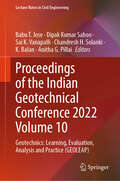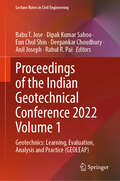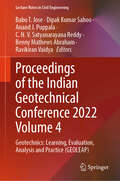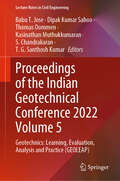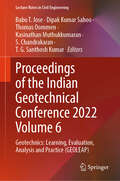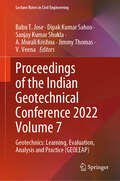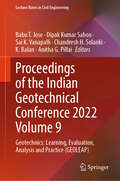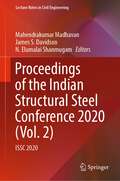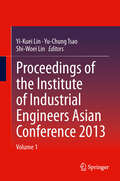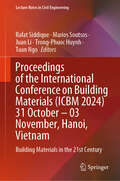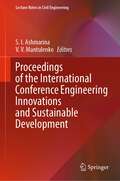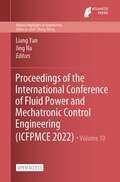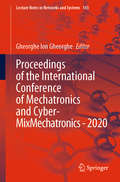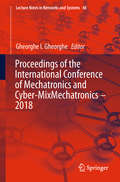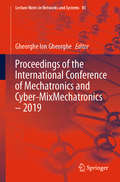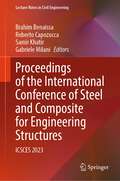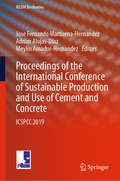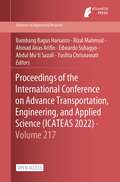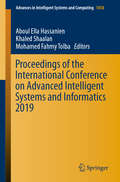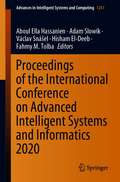- Table View
- List View
Proceedings of the Indian Geotechnical Conference 2022 Volume 10: Geotechnics: Learning, Evaluation, Analysis and Practice (GEOLEAP) (Lecture Notes in Civil Engineering #538)
by Babu T. Jose Dipak Kumar Sahoo Sai K. Vanapalli Chandresh H. Solanki K. Balan Anitha G. PillaiThis book comprises the select proceedings of the Indian Geotechnical Conference (IGC) 2022. The contents focus on recent developments in geotechnical engineering for a sustainable world. The book covers behaviour of soils and soil–structure interaction, soil stabilization, ground improvement, and land reclamation, shallow and deep foundations, geotechnical, geological and geophysical investigation, rock engineering, tunnelling, and underground structures, slope stability, landslides and liquefaction, earth retaining structures and deep Excavations, geosynthetics engineering, geo-environmental engineering, sustainable geotechnics, and landfill design, geo-hydrology, dam and embankment engineering, earthquake geotechnical engineering, transportation geotechnics, forensic geotechnical engineering and retrofitting of geotechnical structures, offshore geotechnics, marine geology, and subsea site investigation, computational, analytical and numerical modelling, and reliability in geotechnical engineering. The contents of this book will be useful to researchers and professionals alike.
Proceedings of the Indian Geotechnical Conference 2022 Volume 1: Geotechnics: Learning, Evaluation, Analysis and Practice (GEOLEAP) (Lecture Notes in Civil Engineering #476)
by Deepankar Choudhury Anil Joseph Babu T. Jose Dipak Kumar Sahoo Eun Chul Shin Rahul R. PaiThis book comprises the select proceedings of the Indian Geotechnical Conference (IGC) 2022. The contents focus on recent developments in geotechnical engineering for a sustainable world. The book covers behaviour of soils and soil–structure interaction, soil stabilization, ground improvement and land reclamation, shallow and deep foundations, geotechnical, geological and geophysical investigation, rock engineering, tunnelling and underground structures, slope stability, landslides and liquefaction, earth retaining structures and deep excavations, geosynthetics engineering, geo-environmental engineering, sustainable geotechnics and landfill design, geo-hydrology, dam and embankment engineering, earthquake geotechnical engineering, transportation geotechnics, forensic geotechnical engineering and retrofitting of geotechnical structures, offshore geotechnics, marine geology and sub-sea site investigation, computational, analytical and numerical modelling, reliability in geotechnicalengineering. The contents of this book are useful to researchers and professionals alike.
Proceedings of the Indian Geotechnical Conference 2022 Volume 2: Geotechnics: Learning, Evaluation, Analysis and Practice (GEOLEAP) (Lecture Notes in Civil Engineering #477)
by Deepankar Choudhury Anil Joseph Babu T. Jose Dipak Kumar Sahoo Eun Chul Shin Rahul R. PaiThis book comprises the select proceedings of the Indian Geotechnical Conference (IGC) 2022. The contents focus on recent developments in geotechnical engineering for a sustainable world. The book covers behaviour of soils and soil–structure interaction, soil stabilization, ground improvement and land reclamation, shallow and deep foundations, geotechnical, geological and geophysical investigation, rock engineering, tunnelling and underground structures, slope stability, landslides and liquefaction, earth retaining structures and deep excavations, geosynthetics engineering, geo-environmental engineering, sustainable geotechnics and landfill design, geo-hydrology, dam and embankment engineering, earthquake geotechnical engineering, transportation geotechnics, forensic geotechnical engineering and retrofitting of geotechnical structures, offshore geotechnics, marine geology and sub-sea site investigation, computational, analytical and numerical modelling, reliability in geotechnical engineering. The contents of this book are useful to researchers and professionals alike.
Proceedings of the Indian Geotechnical Conference 2022 Volume 3: Geotechnics: Learning, Evaluation, Analysis and Practice (GEOLEAP) (Lecture Notes in Civil Engineering #478)
by C. N. V. Satyanarayana Reddy Ravikiran Vaidya Babu T. Jose Dipak Kumar Sahoo Anand J. Puppala Benny Mathews AbrahamThis book comprises the select proceedings of the Indian Geotechnical Conference (IGC) 2022. The contents focus on recent developments in geotechnical engineering for a sustainable world. The book covers behavior of soils and soil–structure interaction, soil stabilization, ground improvement, and land reclamation, shallow and deep foundations, geotechnical, geological and geophysical investigation, rock engineering, tunneling and underground structures, slope stability, landslides and liquefaction, earth retaining structures and deep excavations, geosynthetics engineering, geo-environmental engineering, sustainable geotechnics, and landfill design, geo-hydrology, dam and embankment engineering, earthquake geotechnical engineering, transportation geotechnics, forensic geotechnical engineering and retrofitting of geotechnical structures, offshore geotechnics, marine geology and sub-sea site investigation, computational, analytical and numerical modeling, and reliability in geotechnical engineering. The contents of this book are useful to researchers and professionals alike.
Proceedings of the Indian Geotechnical Conference 2022 Volume 4: Geotechnics: Learning, Evaluation, Analysis and Practice (GEOLEAP) (Lecture Notes in Civil Engineering #479)
by C. N. V. Satyanarayana Reddy Ravikiran Vaidya Babu T. Jose Dipak Kumar Sahoo Anand J. Puppala Benny Mathews AbrahamThis book comprises the select proceedings of the Indian Geotechnical Conference (IGC) 2022. The contents focus on recent developments in geotechnical engineering for a sustainable world. The book covers behavior of soils and soil–structure interaction, soil stabilization, ground improvement, and land reclamation, shallow and deep foundations, geotechnical, geological and geophysical investigation, rock engineering, tunneling and underground structures, slope stability, landslides and liquefaction, earth retaining structures and deep excavations, geosynthetics engineering, geo-environmental engineering, sustainable geotechnics, and landfill design, geo-hydrology, dam and embankment engineering, earthquake geotechnical engineering, transportation geotechnics, forensic geotechnical engineering and retrofitting of geotechnical structures, offshore geotechnics, marine geology and sub-sea site investigation, computational, analytical and numerical modeling, and reliability in geotechnical engineering. The contents of this book are useful to researchers and professionals alike.
Proceedings of the Indian Geotechnical Conference 2022 Volume 5: Geotechnics: Learning, Evaluation, Analysis and Practice (GEOLEAP) (Lecture Notes in Civil Engineering #483)
by Kasinathan Muthukkumaran Babu T. Jose Dipak Kumar Sahoo Thomas Oommen S. Chandrakaran T. G. Santhosh KumarThis book comprises the select proceedings of the Indian Geotechnical Conference (IGC) 2022. The contents focus on recent developments in geotechnical engineering for a sustainable world. The book covers behavior of soils and soil-structure interaction, soil stabilization, ground improvement, and land reclamation, shallow and deep foundations, geotechnical, geological and geophysical investigation, rock engineering, tunneling, and underground structures, slope stability, landslides and liquefaction, earth retaining structures and deep excavations, geosynthetics engineering, geo-environmental engineering, sustainable geotechnics, and landfill design, geo-hydrology, dam and embankment engineering, earthquake geotechnical engineering, transportation geotechnics, forensic geotechnical engineering and retrofitting of geotechnical structures, offshore geotechnics, marine geology and subsea site investigation, computational, analytical and numerical modeling, and reliability in geotechnical engineering. The contents of this book are useful for researchers and professionals alike.
Proceedings of the Indian Geotechnical Conference 2022 Volume 6: Geotechnics: Learning, Evaluation, Analysis and Practice (GEOLEAP) (Lecture Notes in Civil Engineering #484)
by Kasinathan Muthukkumaran Babu T. Jose Dipak Kumar Sahoo Thomas Oommen S. Chandrakaran T. G. Santhosh KumarThis book comprises the select proceedings of the Indian Geotechnical Conference (IGC) 2022. The contents focus on recent developments in geotechnical engineering for a sustainable world. The book covers behavior of soils and soil-structure interaction, soil stabilization, ground improvement, and land reclamation, shallow and deep foundations, geotechnical, geological and geophysical investigation, rock engineering, tunneling, and underground structures, slope stability, landslides and liquefaction, earth retaining structures and deep excavations, geosynthetics engineering, geo-environmental engineering, sustainable geotechnics, and landfill design, geo-hydrology, dam and embankment engineering, earthquake geotechnical engineering, transportation geotechnics, forensic geotechnical engineering and retrofitting of geotechnical structures, offshore geotechnics, marine geology and subsea site investigation, computational, analytical and numerical modeling, and reliability in geotechnical engineering. The contents of this book are useful for researchers and professionals alike.
Proceedings of the Indian Geotechnical Conference 2022 Volume 7: Geotechnics: Learning, Evaluation, Analysis and Practice (GEOLEAP) (Lecture Notes in Civil Engineering #491)
by Sanjay Kumar Shukla A. Murali Krishna Babu T. Jose Dipak Kumar Sahoo Jimmy Thomas V. VeenaThis book comprises the select proceedings of the Indian Geotechnical Conference (IGC) 2022. The book focuses on recent developments in geotechnical engineering for a sustainable world. The book covers behavior of soils and soil-structure interaction, soil stabilization, ground improvement, and land reclamation, shallow and deep foundations, geotechnical, geological and geophysical investigation, rock engineering, tunneling, and underground structures, slope stability, landslides and liquefaction, earth retaining structures and deep excavations, geosynthetics engineering, geo-environmental engineering, sustainable geotechnics, and landfill design, geo-hydrology, dam and embankment engineering, earthquake geotechnical engineering, transportation geotechnics, forensic geotechnical engineering and retrofitting of geotechnical structures, offshore geotechnics, marine geology and subsea site investigation, computational, analytical and numerical modeling and reliability in geotechnical engineering. The book is useful to researchers and professionals alike.
Proceedings of the Indian Geotechnical Conference 2022 Volume 8: Geotechnics: Learning, Evaluation, Analysis and Practice (GEOLEAP) (Lecture Notes in Civil Engineering #492)
by Sanjay Kumar Shukla A. Murali Krishna Babu T. Jose Dipak Kumar Sahoo Jimmy Thomas V. VeenaThis book comprises the select proceedings of the Indian Geotechnical Conference (IGC) 2022. The book focuses on recent developments in geotechnical engineering for a sustainable world. The book covers behavior of soils and soil-structure interaction, soil stabilization, ground improvement, and land reclamation, shallow and deep foundations, geotechnical, geological and geophysical investigation, rock engineering, tunneling, and underground structures, slope stability, landslides and liquefaction, earth retaining structures and deep excavations, geosynthetics engineering, geo-environmental engineering, sustainable geotechnics, and landfill design, geo-hydrology, dam and embankment engineering, earthquake geotechnical engineering, transportation geotechnics, forensic geotechnical engineering and retrofitting of geotechnical structures, offshore geotechnics, marine geology and subsea site investigation, computational, analytical and numerical modeling and reliability in geotechnical engineering. The book is useful to researchers and professionals alike.
Proceedings of the Indian Geotechnical Conference 2022 Volume 9: Geotechnics: Learning, Evaluation, Analysis and Practice (GEOLEAP) (Lecture Notes in Civil Engineering #537)
by Babu T. Jose Dipak Kumar Sahoo Sai K. Vanapalli Chandresh H. Solanki K. Balan Anitha G. PillaiThis book comprises the select proceedings of the Indian Geotechnical Conference (IGC) 2022. The contents focus on recent developments in geotechnical engineering for a sustainable world. The book covers behaviour of soils and soil–structure interaction, soil stabilization, ground improvement, and land reclamation, shallow and deep foundations, geotechnical, geological and geophysical investigation, rock engineering, tunnelling, and underground structures, slope stability, landslides and liquefaction, earth retaining structures and deep Excavations, geosynthetics engineering, geo-environmental engineering, sustainable geotechnics, and landfill design, geo-hydrology, dam and embankment engineering, earthquake geotechnical engineering, transportation geotechnics, forensic geotechnical engineering and retrofitting of geotechnical structures, offshore geotechnics, marine geology, and subsea site investigation, computational, analytical and numerical modelling, and reliability in geotechnical engineering. The contents of this book will be useful to researchers and professionals alike.
Proceedings of the Indian Structural Steel Conference 2020: ISSC 2020 (Lecture Notes in Civil Engineering #318)
by Mahendrakumar Madhavan James S. Davidson N. Elumalai ShanmugamThis book comprises the select peer-reviewed proceedings of the Indian Structural Steel Conference (ISSC 2020). The topics cover state-of-the-art and state-of-the-practice in structural engineering, and latest research in structural modeling and design. Novel analytical, computational and experimental techniques, proposal of new structural systems, innovative methods for maintenance, rehabilitation, and monitoring of existing structures, and investigation of the properties of engineering materials as related to structural behavior are presented in the book. This book will be very useful for structural engineers, researchers, and consultants interested in sustainable materials and steel construction.
Proceedings of the Indian Structural Steel Conference 2020: ISSC 2020 (Lecture Notes in Civil Engineering #319)
by Mahendrakumar Madhavan James S. Davidson N. Elumalai ShanmugamThis book comprises the select peer-reviewed proceedings of the Indian Structural Steel Conference (ISSC 2020). The topics cover state-of-the-art and state-of-the-practice in structural engineering, and latest research in structural modeling and design. Novel analytical, computational and experimental techniques, proposal of new structural systems, innovative methods for maintenance, rehabilitation, and monitoring of existing structures, and investigation of the properties of engineering materials as related to structural behavior are presented in the book. This book will be very useful for structural engineers, researchers, and consultants interested in sustainable materials and steel construction.
Proceedings of the Institute of Industrial Engineers Asian Conference 2013
by Shi Woei Lin Yi Kuei Lin Yu Chung TsaoThis book is based on the research papers presented during The Institute of Industrial Engineers Asian Conference 2013 held at Taipei in July 2013. It presents information on the most recent and relevant research, theories and practices in industrial and systems engineering. Key topics include: Engineering and Technology Management Engineering Economy and Cost Analysis Engineering Education and Training Facilities Planning and Management Global Manufacturing and Management Human Factors Industrial & Systems Engineering Education Information Processing and Engineering Intelligent Systems Manufacturing Systems Operations Research Production Planning and Control Project Management Quality Control and Management Reliability and Maintenance Engineering Safety, Security and Risk Management Supply Chain Management Systems Modeling and Simulation Large scale complex systems
Proceedings of the International Conference on Building Materials: Building Materials in the 21st Century (Lecture Notes in Civil Engineering #585)
by Juan Li Rafat Siddique Marios Soutsos Trong-Phuoc Huynh Tuan NgoThis volume presents articles from the International Conference on Building Materials; ICBM2024 with the theme “Building Materials in the 21st Century”, held at Hanoi in Vietnam, from 31st October to 03rd November. The conference is a diversified-topic forum for international and Vietnamese researchers, academics, industry professionals, experts and policy makers etc. to share their views, and to learn from others about recent and current developments in science and technology of building materials in the 21st century and also to discuss actions required for forthcoming building materials as well as construction development in the future. The book highlights recent research on cement, concrete, refractory materials, fire-resistant materials, paints, glass, product quality testing methods, environmental protection and recycling wastes in building material industry.
Proceedings of the International Conference Engineering Innovations and Sustainable Development (Lecture Notes in Civil Engineering #210)
by S. I. Ashmarina V. V. MantulenkoThis book contains contributions from the international conference “Engineering Innovations and Sustainable Development,” organized by three Russian universities on June 17–18, 2021. By presenting international research on various sustainability issues, it includes topics such as current trends in industrial and agricultural development, innovations in the construction and transport sectors, problems concerning the financing of innovative activities and governmental support for innovations, and engineering competences and skills in the era of new technologies. It also covers the economic, environmental, and informational aspects of sustainable development in the context of innovations. Finally, the book addresses theoretical and practical aspects by studying the phenomenon of sustainability and engineering development in terms of comparing international experiences. It provides significant value for scientists, teachers, and students of higher educational institutions, and specialists, who are researching sustainable development issues in the era of engineering innovations.
Proceedings of the International Conference Industrial and Civil Construction 2021 (Lecture Notes in Civil Engineering #147)
by Sergey Vasil’yevich Klyuev Alexander Vasil’yevich KlyuevThis book gathers the latest advances, innovations, and applications in the field of construction design and management, as presented by researchers and engineers at the International Conference Industrial and Civil Construction 2021, held in Belgorod, Russia, on January 18-19, 2021. It covers highly diverse topics, including building materials, building constructions, structural mechanics and theory of structures, industrial and civil construction, environmental engineering and sustainability. The contributions, which were selected by means of a rigorous international peer-review process, highlight numerous exciting ideas that will spur novel research directions and foster multidisciplinary collaborations.
Proceedings of the International Conference of Fluid Power and Mechatronic Control Engineering (Atlantis Highlights in Engineering #10)
by Liang Yan Jing NaThis is an open access book.Since 1985, held 22 times in different cities all over China, ICFPMCE has now been listed in annual academic activities (non-profit) of the Chinese Society of Theoretical and Applied Mechanics (CSTAM), which has become one of the significant conferences in the field of fluid power and mechatronic control engineering.Under the theme of ‘Green Intelligence, Innovative Development’, ICFPMCE 2022 aims to provide a platform for the participants who have been working in the fields of Fluid mechanics, hydraulic and electrical engineering. In addition to keynote speeches and technical sessions to be hosted by famous experts over the world, the conference will organize a number of mini-symposia with themes of sharing the experiences of applying for the National Natural Science Foundation of China, dialogues between editors-in-chief of the journals and young scholars, experts and entrepreneurs, as well as innovative technology exhibition etc., in order to highlight the significant subjects and trends in the field.
Proceedings of the International Conference of Mechatronics and Cyber- MixMechatronics - 2020 (Lecture Notes in Networks and Systems #143)
by Gheorghe Ion GheorgheThis book presents state-of-the-art research in the field of mechatronics and cyber-mixmechatronics, gathering papers from almost all continents. Featuring contributions by research scholars in both government-financed institutions and in the business environment, it offers a clear picture of the innovations emerging in the field. The book is not limited to mechatronics, but also covers all the smart technical sciences, and discusses promising medical applications based on nanotechnologies.As such, it is a valuable resource for students wanting to learn from leading scholars, as well as for researchers in all areas of engineering.
Proceedings of the International Conference of Mechatronics and Cyber-MixMechatronics – 2018 (Lecture Notes in Networks and Systems #48)
by Gheorghe I. GheorgheThis proceedings book gathers contributions presented at the 2nd International Conference of Mechatronics and Cyber-MixMechatronics/ICOMECYME, organized by the National Institute of R&D in Mechatronics and Measurement Technique in Bucharest, Romania, on September 6th–7th, 2018. Further, it reflect the expansion of the field of Mechatronics, which has yielded newer trans-disciplinary fields including Adaptronics, Integronics, and Cyber-Mix-Mechatronics. These are also the topics addressed by the respective book chapters. The conference has a rich scientific tradition and attracts specialists from all over the world – including North America, South America, and Asia. ICOMECYME is focused on presenting research results and is mainly directed at academics and advanced students, but also offers a venue for interacting with R&D experts. These proceedings will especially benefit entrepreneurs who want to invest in research and who are open for collaborations.
Proceedings of the International Conference of Mechatronics and Cyber-MixMechatronics – 2019 (Lecture Notes in Networks and Systems #85)
by Gheorghe Ion GheorgheThese proceedings gather contributions presented at the 3rd International Conference of Mechatronics and Cyber-MixMechatronics/ICOMECYME, organized by the National Institute of R&D in Mechatronics and Measurement Technique in Bucharest, Romania, on September 5th–6th, 2019. Reflecting the expansion mechatronics, it discusses topics in the newer trans-disciplinary fields, such as adaptronics, integronics, and cyber-mixmechatronics. With a rich scientific tradition and attracting specialists from around the globe – including North America, South America, and Asia – ICOMECYME focuses on presenting the latest research. It is mainly directed at academics and advanced students, but also appeals to R&D experts, offering a platform for scientific exchange. These proceedings are a valuable resource for entrepreneurs who want to invest in research and who are open for collaborations.
Proceedings of the International Conference of Steel and Composite for Engineering Structures: ICSCES 2023 (Lecture Notes in Civil Engineering #486)
by Samir Khatir Gabriele Milani Roberto Capozucca Brahim BenaissaThis volume provides the latest developments in the field of steel and composite for engineering applications, as presented at the International Conference on Steel and Composite for Engineering Structures (ICSCES), held in Lecce, Italy on November 20-21, 2023. It covers interest topics like control and vibration, damage in composite materials, fracture and damage mechanics, construction management, damage tolerance, safety, security, and reliability, big data analytics, topology optimization and artificial intelligence, mechanical and material engineering, structural health monitoring, computer-aided design and manufacturing, crack initiation and propagation, performance and optimization, computational fracture mechanics, inverse problem, non-destructive testing, signal processing, artificial intelligence. It serves as a reference work for professionals and students in the areas of civil engineering, applied natural sciences and engineering management.
Proceedings of the International Conference of Sustainable Production and Use of Cement and Concrete: ICSPCC 2019 (RILEM Bookseries #22)
by Jose Fernando Martirena-Hernandez Adrian Alujas-Díaz Meylin Amador-HernandezThis volume gathers the latest advances, innovations and applications presented by leading international researchers and engineers at the International Conference on Sustainable Production and Use of Cement and Concrete (ICSPCC 2019), held in Villa Clara, Cuba on June 23-30, 2019. It covers highly diverse topics, including sustainable production of low-carbon cements, novelties in the development of supplementary cementitious materials, new techniques for the microstructural characterization of construction materials, Portland-based and alkaline-activated cementitious systems, development of additives and additions in the sustainable production of concrete, sustainable production of high-performance concrete, durable concrete produced with recycled aggregates, development of mortars for historical patrimony restoration, environmental and economic assessment of the production and use of cement. The contributions, which were selected by means of a rigorous, international peer-review process, highlight numerous exciting ideas that will inspire novel research directions and foster multidisciplinary collaboration between different specialists.
Proceedings of the International Conference on Advance Transportation, Engineering, and Applied Science (Advances in Engineering Research #217)
by Bambang Bagus Harianto Rizal Mahmud Ahmad Anas Arifin Edwardo Subagyo Abdul Mu’ti Sazali Yusfita ChrisnawatiThis is an open access book. The ICATEAS 2022 event is organized by the Aviation Polytechnic of Surabaya, a college under the Ministry of Transportation, Republic of Indonesia. This is a program to provide an opportunity for researchers to be able to present the results of their thoughts and publish them on international proceedings. The publication is very important for academics to develop careers and to develop knowledge in general.
Proceedings of the International Conference on Advanced Intelligent Systems and Informatics 2019 (Advances in Intelligent Systems and Computing #1058)
by Mohamed Fahmy Tolba Aboul Ella Hassanien Khaled ShaalanThis book presents the proceedings of the 5th International Conference on Advanced Intelligent Systems and Informatics 2019 (AISI2019), which took place in Cairo, Egypt, from October 26 to 28, 2019. This international and interdisciplinary conference, which highlighted essential research and developments in the fields of informatics and intelligent systems, was organized by the Scientific Research Group in Egypt (SRGE). The book is divided into several sections, covering the following topics: machine learning and applications, swarm optimization and applications, robotic and control systems, sentiment analysis, e-learning and social media education, machine and deep learning algorithms, recognition and image processing, intelligent systems and applications, mobile computing and networking, cyber-physical systems and security, smart grids and renewable energy, and micro-grid and power systems.
Proceedings of the International Conference on Advanced Intelligent Systems and Informatics 2020 (Advances in Intelligent Systems and Computing #1261)
by Václav Snášel Aboul Ella Hassanien Fahmy M. Tolba Adam Slowik Hisham El-DeebThis book presents the proceedings of the 6th International Conference on Advanced Intelligent Systems and Informatics 2020 (AISI2020), which took place in Cairo, Egypt, from October 19 to 21, 2020. This international and interdisciplinary conference, which highlighted essential research and developments in the fields of informatics and intelligent systems, was organized by the Scientific Research Group in Egypt (SRGE). The book is divided into several sections, covering the following topics: Intelligent Systems, Deep Learning Technology, Document and Sentiment Analysis, Blockchain and Cyber Physical System, Health Informatics and AI against COVID-19, Data Mining, Power and Control Systems, Business Intelligence, Social Media and Digital Transformation, Robotic, Control Design, and Smart Systems.
